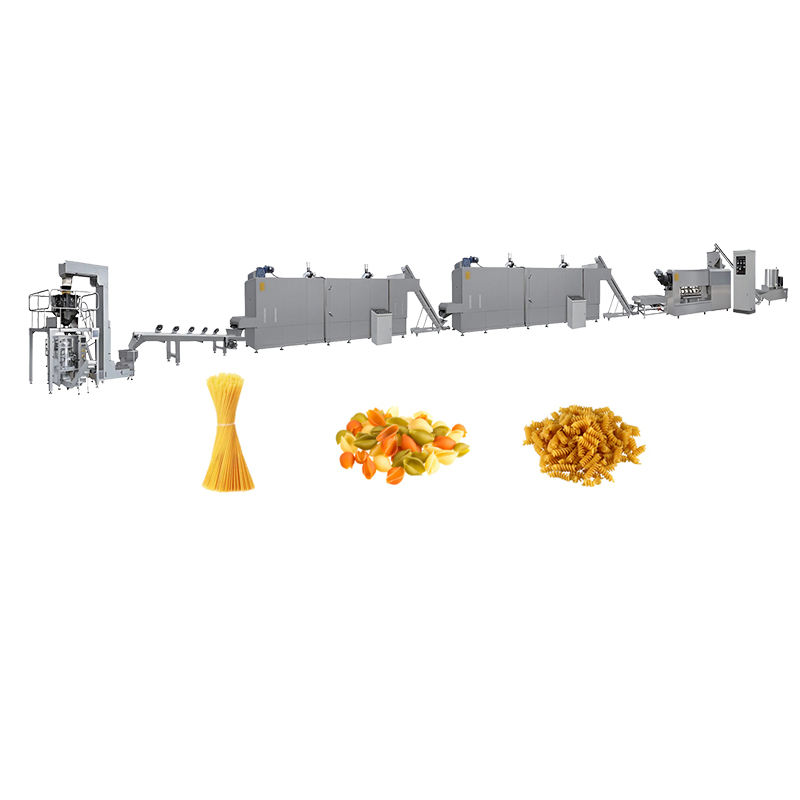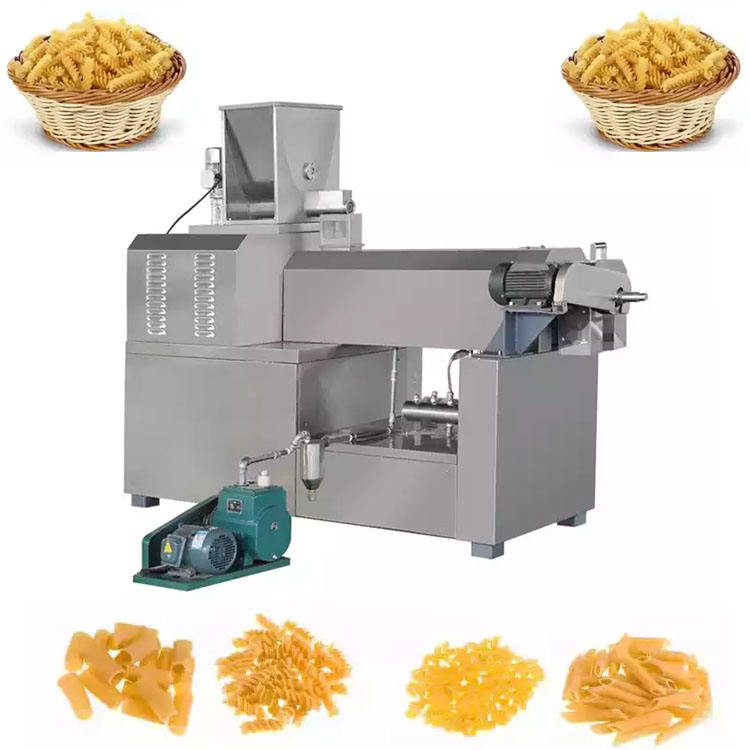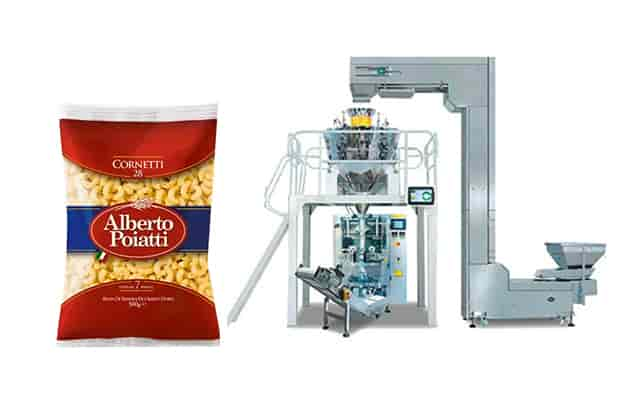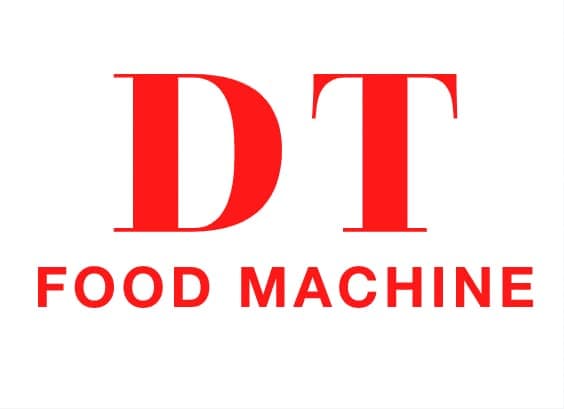Introducere
În ultimii ani, Cererea globală de paste uscate a crescut, condus de schimbarea obiceiurilor alimentare, comoditate, și stiluri de viață urbane. Printre diferitele tipuri de paste, Macaroni Machine continuă să fie un element fundamental în case, Restaurante, și mărci de masă gata. Pentru a satisface cerințele din ce în ce mai mari de piață, menținând în același timp consistența de înaltă calitate și producție, many food manufacturers are turning to fully automatic macaroni machines.
These industrial-grade machines streamline the entire pasta-making process — from mixing raw ingredients to drying the final product — all while minimizing manual intervention. This article provides a detailed look at the components, functionality, and advantages of a fully automatic macaroni production system for commercial applications.

Understanding the Fully Automatic Macaroni Machine
A fully automatic macaroni machine is an integrated production system designed to manufacture pasta at scale. It automates every stage of production, ensuring a smooth, igienic, and energy-efficient process. These systems are typically installed in commercial or industrial pasta plants and are engineered to run continuously, producing large volumes with minimal downtime.
The machine includes all essential components: mixer pentru aluat, sistem de extrudare, pasta cutter, uscător, and often a cooling and packaging section. Operators monitor the process via a PLC-based control panel that allows fine-tuning of variables such as temperature, umiditate, cutting length, and extrusion pressure.
Why Choose a Fully Automatic Macaroni Machine?
Implementing a fully automatic solution offers several clear advantages:
- High throughput: Capable of producing hundreds of kilograms of macaroni per hour
- Calitate constantă a produsului: Uniform shape, culoare, and moisture levels
- Reducerea forței de muncă: Fewer operators needed due to automation
- Lower operating costs: Energy-efficient motors and dryers
- Compliance with food safety standards: Stainless steel design, curatare usoara
- Customizable output: Supports a wide range of pasta shapes through interchangeable molds
For commercial pasta producers aiming to scale without sacrificing quality, this technology is a long-term investment.
Main Components of the Production Line
A complete macaroni production system comprises several interlinked units. Below is an overview of each:
1. Sistem de amestecare a aluatului
Mixes durum wheat semolina and water under controlled conditions. Some systems include a vacuum mixer to eliminate air pockets in the dough, intensificarea texturii.
2. Screw Conveyor
Transports the hydrated dough to the extruder without manual intervention.
3. Extruder
The heart of the system. Uses single or twin screws to compress and push the dough through a custom die, shaping it into macaroni. The extruder chamber is typically jacketed for temperature control.
4. Sistem de tăiere
High-speed rotary blades slice the extruded pasta into specific lengths. The cutting speed can be adjusted to match product specifications.
5. Drying Tunnel
A multi-stage, temperatură- and humidity-controlled chamber that gradually reduces moisture content in the macaroni, preventing cracking and preserving texture.
6. Transportor de răcire
Post-drying, the macaroni is cooled to room temperature to avoid condensation and spoilage during packaging.
7. Panou de control PLC
User interface for managing parameters and diagnosing system faults. Most systems use Siemens, Mitsubishi, or Delta controllers.
8. Optional Packaging Line
Some setups include automated packaging, weighing, and labeling units.

Specificatii tehnice (Sample Reference)
| Caracteristică | Valoare |
|---|---|
| Capacitatea de producție | 100–1000 kg/oră |
| Consumul de energie | 50–180 kW (depends on capacity) |
| Voltaj | 380V / 50Hz (personalizabil) |
| Material de construcție | Food-grade SUS304 |
| Tipul de extrudare | Single or twin-screw |
| Sistem de control | PLC + touch screen |
| Pasta Shapes | Multiple via interchangeable dies |
| Machine Length | 15–35 meters |
| Tip uscător | Circulating hot air |
| Certificări | CE, ISO 9001, HACCP compliant |
How the System Works
The entire process is designed for flow and precision. Here’s a step-by-step overview:
- Raw Material Mixing: Semolina is blended with water until uniform dough forms.
- Hrănirea cu aluat: The screw conveyor moves the dough to the extrusion chamber.
- extrudare & Modelarea: Under pressure, dough passes through metal dies that form specific macaroni shapes.
- Tăiere: As the pasta exits the die, it’s cut by rotating blades to the desired length.
- Uscare: Moisture is removed in a multi-phase drying tunnel. Parameters like temperature and air speed are automatically adjusted to match the recipe.
- Răcire: The product is gradually brought to ambient temperature to stabilize it.
- Final Output: Dried, cooled pasta moves to packaging or bulk collection.

Supported Pasta Shapes
The fully automatic macaroni machine can produce a wide range of pasta shapes beyond traditional elbows. By switching molds, manufacturers can produce:
- Elbows
- Penne
- Scoici
- Fusilli
- Care dintre ele
- Rigatoni
- Tubetti
- Spiral noodles
Installation Requirements
To ensure smooth setup, the following conditions should be met:
- Factory Space: At least 50–100m², depending on line length
- Electrical Supply: 3-phase 380V with stable voltage
- Water Supply: Clean water for mixing and cooling
- Ventilare: Essential for dryer exhaust and factory safety
- Drainage System: For cleaning operations
Installation typically takes 3–5 working days, including testing and operator training.
Operation & Întreţinere
Though largely automated, the system still requires routine checks to maintain optimal performance:
Sarcini zilnice
- Clean extrusion dies and cutting blades
- Remove dough residues from conveyor belts
- Check temperature logs in drying tunnel
Sarcini săptămânale
- Inspect all seals and gaskets
- Verify fan operation in dryer
- Clean control panel interface
Long-Term Maintenance
- Replace worn screw elements (~3–5 years)
- Lubricate motors and gear reducers
- Inspect heater coils and replace if needed
Common Operational Challenges
| Emisiune | Cauza probabilă | Soluţie |
|---|---|---|
| Pasta sticking in dryer | Incomplete pre-drying | Adjust pre-drying temperature |
| Uneven drying | Fan malfunction | Check fan speed and replace filters |
| Cracked macaroni | Too rapid moisture loss | Lower drying temperature |
| Short product length | Blade speed too high | Adjust cutter rotation speed |
| Irregular pasta shape | Worn die | Replace die or polish interior surface |
Production Cost & Estimarea rentabilității investiției
Let’s consider a 300 kg/h setup:
| Articol | Valoare |
|---|---|
| Costul mașinii | $50,000–$70,000 |
| Electricity Usage | ~20 kWh/hour |
| Manpower Required | 2–3 persons |
| Ieșire zilnică (8h) | 2.4 tone |
| Operating Days/Month | 26 days |
| Perioada ROI | 6–10 months (depending on local pasta price and utility cost) |
The faster ROI is one of the main reasons why food processors adopt this technology.

How to Select the Right Macaroni Machine
When choosing a macaroni production system, keep the following in mind:
- Target output volume: Choose a model that fits your daily capacity needs
- Pasta types you plan to produce: Make sure molds for desired shapes are available
- Local regulations: Ensure machine complies with CE, FDA, or local food safety standards
- Suport tehnic: Check if the supplier offers training, depanare de la distanță, or local service
- Buget: Don’t over-invest early. Start with a mid-range machine if you’re new to pasta production
Recommended Manufacturers
Several manufacturers specialize in reliable macaroni equipment. A few noteworthy ones include:
- DT Food Machinery Co., Ltd. (China) – Offers customizable, high-output machines with strong after-sales service.
- Grupul Pavan (Italia) – Well-established, premium machines, ideal for large-scale pasta factories.
- Anko Food Machine Co., Ltd. (Taiwan) – Focuses on mid-capacity setups and flexible molds.
- FENCO (Italia) – Known for modular pasta production lines with advanced drying technologies.
Siguranţă & Certificare
High-grade machines comply with stringent international standards:
- Certificat CE for electrical and mechanical safety
- ISO 9001 for consistent quality management
- GMP Compliant for clean-in-place capability
- HACCP protocols supported in design
- Food-grade contact materials (SUS304/316)
Many systems also include emergency shut-offs, thermal sensors, și protectie la suprasarcina for safe operation.
Case Example: Mid-Sized Pasta Plant in Eastern Europe
A factory based in Romania installed a 500 kg/h macaroni line sourced from a reputable Chinese manufacturer. With only 4 operators per shift, they now produce over 120 tons of pasta per month, supplying both private-label brands and national retailers.
Key highlights:
- Machine length: 26 meters
- Electricity cost: $0.09/kWh
- Monthly utility cost: ~$2,100
- ROI achieved in just 8 luni
- Shapes: cot, Penne, rigatoni
Concluzie
A fully automatic macaroni machine is not just a tool; it’s a strategic asset for food manufacturers aiming to capture growing demand for high-quality, shelf-stable pasta products. By automating every stage — from mixing to drying — these machines offer consistency, Scalabilitate, and cost-efficiency that manual or semi-automatic systems can’t match.
Whether you’re expanding an existing pasta facility or starting a new production line, investind într-un sistem de încredere, certified macaroni machine can significantly boost your productivity and profitability over the long term.
